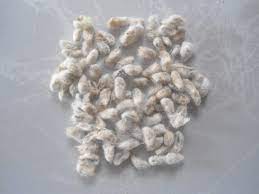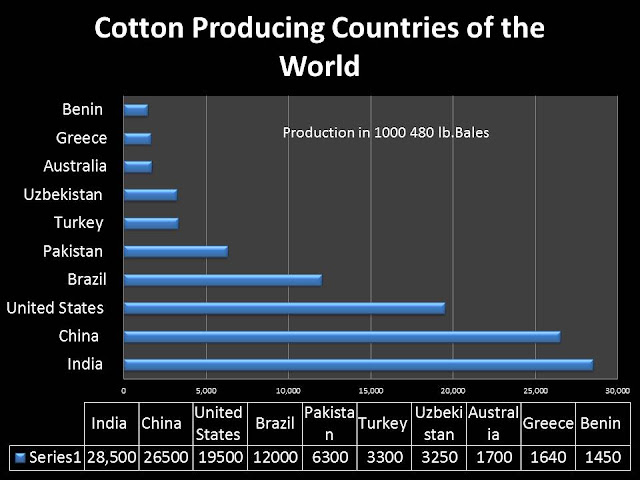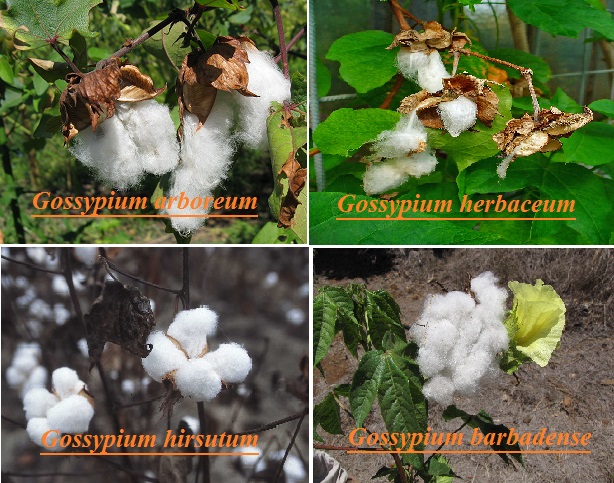Cultivation of Cotton; A Complete Guide of Information
Cultivation of Cotton; A Complete Guide of Information
|
States |
Production (2019-20) Bales /Year |
Area (Hectares) |
Yield (Kg/Hectares) |
|
Gujarat |
95 Lakh |
26.59 lakh |
556.22 |
|
Maharashtra |
82 Lakh |
42.54 lakh |
307.71 |
|
Telangana |
53 Lakh |
18.27 lakh |
437.33 |
|
Rajasthan |
25 Lakh |
6.29 lakh |
675.68 |
|
Haryana |
22 Lakh |
7.08 lakh |
552.26 |
|
Madhya Pradesh |
20 Lakh |
5.79 lakh |
664.5 |
|
Karnataka |
18 Lakh |
6.88 lakh |
370.64 |
|
Punjab |
13 Lakh |
2.68 lakh |
729.48 |
|
Tamilnadu |
6 Lakh |
1.31 lakh |
778.63 |
|
Odisha |
4 Lakh |
1.58 lakh |
484.18 |
Importance of Cotton ;
Classification of Cotton Crop ;
Cotton belongs to the Malvaceae family and the genus Gossypium. The genus Gossypium has been one of the most difficult to classify. Genus Gossypium includes 20 species of cotton including wild as well as cultivated species. The cultivated species have spinnable lint while wild species have only short seed fuzz or smooth seeds.
The Following four cultivated species contain almost all the varieties of cotton cultivated in India.
(1) Gossypium arboreum: This species of cotton is most widely distributed in the country. Plant height is 1.5 to 2 meters. Twigs and leaves are pubescent. Leaves have five to seven lobes. The fibers are coarse and short, their length being mostly from 1.25 to 2.10 cm. This species covers about 29 % of the total acreage of cotton in the country.
(2) Gossypium herbaceum: The plant is 1 to 1.5 m tall. The stem is thick and rigid, leaves and twigs sparsely hairy. Leaves are flat with three to seven lobes. Seeds are with small fuzz and lint. Fiber length is mostly 1.25 to 2.30 cm. This species covers about 21 % of the total cotton acreage.
(3) Gossypium hirsutum: This is a group of cotton commonly known as American cotton’. Plants are about 1.5 m tall. The stem is usually green or brown. Leaves and twigs are densely hairy. Leaves have three tv five lobes. Flowers are creamy-white when first open but soon turn pina or red. Fibre length is 1.8 to 3.1 cm or more. These species cover about 50 % of the area of cotton.
(4) Gossypium barbadense: This is a group of cotton commonly known as ‘Sea Island cotton’ that includes most of the long staple cotton of and the U.S.A. Fibre length is 3.6 to 5.0 cm. The lint is te detached from the seed. It has very fine fibre. Flowers are usually yellow in colour with
purple spots. The area under this species is only a few thousand hectares
Climatic Requirements for Cotton Crop Cultivation;
1) Cotton is a warm-season crop. It requires a mean annual temperature of over 10°C and an annual rainfall of at least 50 cm distributed throughout the growing season.
Soil Requirement for Cotton Crop Cultivation;
1) Cotton can be successfully grown on all soils except the sandy, saline, and waterlogged soils.
Important Varieties of cotton Crop;
|
North Zone |
Central Zone |
South Zone |
|
MRC 6301 |
M ECH-12 |
M ECH-1 62 |
|
MRC-6304 |
MECH-162 |
MECH-184 |
|
RCH-134 |
MECH-184 |
MRC-6322 |
|
RCH-317 |
MRC-6301 |
MRC-6918 |
|
RCH-308 |
RCH-2 |
RCH-2 |
|
RCH-314 |
RCH -118 |
RCH -20 |
|
Ankur-651 |
RCH-138 |
RCH -368 |
|
Ankur-2534 |
RCH-144 |
RCH -371 |
|
MRC-6025 |
Ankur-651 |
RCH-111 |
|
MRC-6029 |
Ankur-09 |
RCHB-768 |
|
NCS-913 |
Mallika |
NCH-145 |
|
NCS-138 |
Bunny |
NCH-207 |
|
J KCH-1947 |
NCS-145 |
NCH-913 |
|
NCEH-6R |
NCS-207 |
Mallika |
|
|
GK-205 |
Bunny |
Rotations and Mixed Cropping in Cotton Crop ;
In Northern India many rotations of crops involving feasible. Crops like wheat, gram, pea, linseed, berseem, etc., can after the harvest of cotton.
1. Cotton-wheat
In southern India cotton–sorghum-ragi is an important crop rota in irrigated areas. Intercropping with ragi, other millets, or groundnut also quite common in parts of Tamil Nadu, Karnataka, and Andhra Pradesh.
Field Preparation for Cotton Cultivation ;
Cotton, being a deep-rooted crop, requires a well-prepared seedbed. The field, after the harvest of the preceding crop, should be ploughed 15-20 cm deep with a mouldboard plough. Thereafter three or four harrowings or four to five ploughings with local plough should be given, After each ploughing, planking is essential to make soil pulverized and leveled. No stubbles of the previous crop should be left in the field.
Seed and Sowing in Cotton Crop;
 |
| Cotton Seeds |
Seed rate varies according to the variety, its growth behavior, soil fertility, and production practices.
Timely sowing of cotton is the single key factor to influence cotton yields. Hence sowing should be done within the most optimum time, as sowing earlier and later than the normal time results in a considerable reduction in cotton yield.
In the central zone, irrigated cotton should be sown between 15th and 25th May whereas rainfed cotton should be sown with the onset of monsoon. In Tamil Nadu, irrigated as well as rainfed crop is sown in September October. In parts of Karnataka and Andhra Pradesh, the desi cotton is sown in August-September.
Sowing is done generally by drilling the seed in rows. Line sowing with seed drill is recommended in order to ensure uniform germination, better stand and easy inter cultivation. The seed should be uniformly placed at a depth of 4-5 cm and properly covered with moist soil. The seeds placed too shallow dry up without germination, and those too deep find it difficult to come to the surface, the result in both cases being patch germination and poor crop stand.
5) Gap Filling and Thinning;
Whatever may be the method of sowing, still some gap there. Immediately after the emergence of seedlings, go through and fill the gaps by dibbling water-soaked seeds to have quick emergence.
In the case of excess seedlings remove seedlings that are weak, diseased damaged. Thus plants in clusters would be thinned out retaining and strong plants. The spacing between plants in a row should be kept 45 cm in American cotton and 30-35 cm in desi cotton.
Manures and Fertilisers Requirement in Cotton Crop;
The cotton plant is a heavy feeder that needs proper manuring for successful cultivation. Farmyard manure or compost is rarely applied to the cotton crop. Manures and fertilizers both play important role in cotton cultivation.
1) Northern cotton zone;
Water Management in Cotton Cultivation ;
Weed Control in Cotton Crop;
Interculture in cotton is necessary to create mulch, aeration of the topsoil, better intake of water, and the control of weeds. Cotton is highly vulnerable to weed competition especially in the initial stage of growth (50-60 days of its growth). Hence control of weeds either by manual labor or by weedicides is essential to get good yields. Dry hoeing with a hand hoe or spade five to six weeks after sowing or before first irrigation is very effective in controlling the weeds. It should be repeated afterward if necessary.
Diseases and Pest Management in Cotton Crop;
a) Diseases Management in Cotton;
The cotton crop is attacked by a number of diseases. Symptoms of important diseases and their suitable control measures are given below:
1)Root Rot ;
This disease is caused by soil-borne fungi The loss in yield results due to a reduction in plant stand by way of the sudden death of plants. The disease appears in patches. Due to this disease, perfectly healthy plants may wilt within 24 hours with leaves drooping without showing any discoloration Roots rot and bark of the affected roots shred,
Control Measures (1) Seed treatment with Carboxin or Thiram at 5 g or Carbendazim at 2g/kg.
This disease is caused by a soil-borne fungus The disease causes a considerable reduction in yield. In young, as well as old plants the initial symptoms are stunting followed by yellowing, and drooping of most of the leaves. In old plants, lower leaves towards the base are affected first followed by younger ones towards tips. Leal discoloration appears around the edges and progresses towards the midrib and leaves gradually drop.
Control Measures ;
The disease chiefly attacks seedlings, bracts and bolls Affected seedlings have reddish or dark brown lesions on the stems below the soil surface and on roots. Symptoms on bracts appear in the form of circular water-soaked spots which enlarge and may spread to the bolls When the diseased area extends to the base of the boll, the bolls she away.
Control Measures;
4) Bacterial Blight ;
In the northern region, infected seeds are the primary source of infection while in the southern region plant debris is the main source of infection. The disease attacks at all stages of crop growth. The losses in yield and quality of lint result due to heavy drop of leaves, young bolls and squares, and rotting of bolls. Defoliation causes the shedding of young bolls and thus leads to a reduction in yield.
Control Measures ;
1) Treat the seed with treat the acid delinted seeds with Carboxin or Oxycarboxin at 2 g/kg or soak the seeds in 1000 ppm Streptomycin sulphate overnight.
5) Myrothecium Leaf Spot ;
The disease affects leaves, bracts as well as bolls and humid. Losses and usually appears when the climate is quite wet and
Control Measures;
1) Spray Blitox or Fytolan or Difolatan at the rate of 2 kg per hectare with the first initiation of the disease.
6) Bolt Rot ;
A large number of fungi and bacteria cause the bolt rot. Bolt rots cause considerable damage by directly reducing the yield of seed cotton and quality of libre.
Control Measures;
Rigorous spraying with copper oxychloride at the rate of 2 kg per hectare and Carbaryl insecticide at the rate of 2 kg per hectare at boll formation stage at 10-15 days interval three to four times would be helpful
b) Insect and Pests Mangement in Cotton Crop
Cotton crop is subject to attack by a number of insect pests. A brief description of the major ones, their nature of the damage, and appropriate control measures are given below:
1) Pink Boll Worm;
It is a notorious pest of cotton in all cotton-growing areas. It affects the cotton yield in several ways.
(a) Flower damage: When flower buds are bored by this pest, they drop off prematurely, Caterpillars boring into the flower, seal the tips of the flower petals together with a fine web. This gives the flower a rosette appearance.
(b) Damage to lint; The caterpillar enters into the boll, it cuts through the developing lint to a seed. As a result, the lint development is retarded and the lint is weakened.
(c) Damage to seed; Seed kernel is the preferred food of the caterpillar. It devours the internal contents of the seed completely. By eating the seeds, it reduces yield, viability, and oil content of the seed. Infestation lowers germination power of the seed
Control Measures ;
1) Heating the seeds for a few minutes at 60°C kills the hibernating larvae in the seeds. Fumigation of the seeds with methyl bromide the rate of 1.3 kg per 100 cubic meter for a day or with Phostoxin 200 tabstets per 100 cubic meter may be quite effective
(2) Destruction of host plants during off-season may be useful
2) Spotted Boll Worm;
It is one of the most damaging pests of cotton. This pest is in cotton fields for a long period. It affects the cotton yield in several ways
(a) Shoot wilting;: The incidence of the pest is noticed five to six weeks after sowing. The larva of this pest enters into the terminal bud of the vegetative shoot and tunnels downward. As a result, the growing point is killed and shoot droops down. The attacked shoots wither and die, ultimate
(b) Bud damage: Later the caterpillar bores into the developing flower buds and feeds on the pollen of the flower bud. The bracteoles of damaged flower buds open out, causing the condition is known as ‘flared sauqres The feeding also causes severe shedding of flower buds.
(c) Lint damage: As the bolls develop, the larva bores into the bolt Only unripe bolls are attacked. Small attacked bolls turn brown, rot, and drop off whereas bigger bolls do not fall but there is the premature opening of the bolls. The internal content of the boll is completely destroyed and the quality of the lint is drastically reduced.
1) Use a pheromone trap to monitor the adult moth activity
2) Apply insecticides: Phosalone 35% EC 2000 ml/ha or • Triazophos 40 EC 2.5l/ha
It is commonly known as gram pod borer as it is a serious pest of pulses too. It also causes substantial damage to cotton by boring into bolls. The pest feeds on tender top shoot leaves, flower buds, and bolls of the cotton. The affected boll shows a large hole on it.
Control Measures ;
|
Group and name of the Chemical |
Formulation |
Quantity of chemical ml or g/ha |
|
Carbamates |
|
|
|
Methomyl |
25 EC |
2000 |
|
Thiodicarb |
75 WP |
2000 |
|
Organophosphorus compounds (OP) |
|
|
|
Acephate |
75 WP |
780 |
|
Chlorpyriphos |
20 EC |
1250 |
|
Profenophos |
50 EC |
1500 |
|
Quinolphos |
25EC |
2000 |
|
Triazophos |
40EC |
1500 |
|
Insect growth regulators (IGR) |
|
|
|
Novuluron |
10 EC |
1000 |
|
Lufenuron |
5 EC |
1200 |
|
Diafenthiuron |
50 WP |
700 |
|
Buprofezin |
25 EC |
400 |
|
Pyriproxyfen |
10 EC |
500 |
|
Oxidiazine |
|
|
|
Indoxacarb |
15 EC |
500 |
|
Spinosyn |
48 EC |
100 |
|
Avermectin |
|
|
|
Emamectin Benzoate |
5 EC |
200 |
|
Group and name of the Chemical |
Formulation |
Quantity of chemical ml or g/ha |
|
Carbamates |
|
|
|
Methomyl |
25 EC |
2000 |
|
Thiodicarb |
75 WP |
2000 |
|
Organophosphorus compounds (OP) |
|
|
|
Acephate |
75 WP |
780 |
|
Chlorpyriphos |
20 EC |
1250 |
|
Profenophos |
50 EC |
1500 |
|
Quinolphos |
25EC |
2000 |
|
Triazophos |
40EC |
1500 |
|
Insect growth regulators (IGR) |
|
|
|
Novuluron |
10 EC |
1000 |
|
Lufenuron |
5 EC |
1200 |
|
Diafenthiuron |
50 WP |
700 |
|
Buprofezin |
25 EC |
400 |
|
Pyriproxyfen |
10 EC |
500 |
|
Oxidiazine |
|
|
|
Indoxacarb |
15 EC |
500 |
|
Spinosyn |
48 EC |
100 |
|
Avermectin |
|
|
|
Emamectin Benzoate |
5 EC |
200 |
4 ) Jassids, Aphids, Thrips, And White Fly ;
These small insects suck the sap of leaves. The leaves of infested plants curl downwards and turn pale yellow or bronze. Severe attacks by these insects may lead to the complete withering of the plants.
Control Measures;
Spray the cotton crop with Methyl demeton 25 EC 500ml/ha or Acetamiprid 20% SP 50 g/ha or Buprofezin 25% SC1000 ml/ha or Fipronil 5% SC 1500-2000 ml/ha or Imidacloprid 17.8% SL 100 -125 ml/ha
Caterpillar of this pest rolls a leaf around itself and lives inside eating away the green matter of the leaf. The full-grown caterpillar about 5-6 centimetres in length and pupates inside the roll itself.
Control Measures;
1) Remove the rolled leaves.
Harvesting of Cotton Crop;
1) Cotton is harvested in three or four pickings by hand as the boll matures. Cotton should be picked clean (free from dry leaves, bracts, etc.) and dried to get a good price in the market.






Pingback: Cultivation of Jute (Corchorus spp.) in India - Agrovista-Farming
Excellent items from you, man. I’ve remember your stuff prior to and you’re simply too magnificent. I actually like what you have received right here, certainly like what you are stating and the way during which you assert it. You make it enjoyable and you continue to care for to stay it wise. I can not wait to read much more from you. That is actually a wonderful web site.
Nice post. I learn one thing more difficult on completely different blogs everyday. It can all the time be stimulating to learn content material from different writers and observe a little bit something from their store. I抎 desire to use some with the content material on my weblog whether you don抰 mind. Natually I抣l offer you a hyperlink on your internet blog. Thanks for sharing.
whoah this blog is great i love reading your articles. Keep up the great work! You know, many people are looking around for this information, you can help them greatly.